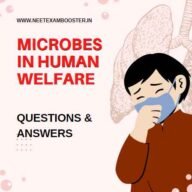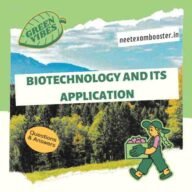Chapter 12: Biotechnology and its Application Class 12
Biotechnology and its Application Class 12:- Biotechnology is use of biology for the manufacturing of products and the technologies for welfare of the human beings. It has a wide range of the applications in the agriculture and the medicine. The genetically modified crops and gene therapy are latest advancements in field of biotechnology. Genetically modified the crops are manufactured by incorporating the genes with desired characteristics in a plant. This has helped in development of the disease-free and the pest-resistant crops. Thus, biotechnology has helped a great deal in the manufacturing of technologies for sustainable development.

Biotechnology and its Application Class 12 – Very Short Answer Types Questions
Q.1. What do you mean by GMO? How does they differ from a hybrid?
A.1. GMOs are the Genetically Modified Organisms. These are created by inserting genes from DNA of a species with desired characteristics into genes of an unrelated plant or the animal. A hybrid is produced when pollen of one plant is used to fertilize some of the unrelated plant species. Also when animals of two different species breed, a hybrid is formed. On contrary, GMOs are created by incorporating genes with the desired characteristics from a plant or animal of one species to DNA of a different species.
Q.2. What do you mean by ELISA?
A.2. ELISA stands for the Enzyme-Linked Immunosorbent Assay. It is a method in which a target antigen is captured in the samples using a specific antibody and the target molecule is detected using an enzyme reaction with a substrate.
Q.3. What do you mean by Biopiracy?
A.3. Biopiracy is commercial exploitation of the naturally occurring biochemical or the genetic material by obtaining the patents that restrict its future use without paying any compensation to native community.
Q.4. Why shouldn’t patent on the Basmati have gone to an American company?
A.4. The patent on the Basmati shouldn’t have gone to an American company for following reasons:
- Basmati rice variety traditionally belongs to India.
- Patented variety of the Basmati was derived from the‘Indian farmer’s variety’.
Q.5. Which is first transgenic cow? Which gene was being inserted into it?
A.5. First transgenic cow was named as Rosie. Gene inserted into the cow was human alpha-lactalbumin.
Biotechnology and its Application Class 12 Quiz
Q.6. Explain GEAC? Write its main objectives?
A.6. GEAC is the Genetic Energy Approval Committee. It is the Indian government organization. The main objectives are as follows:
- To examine validity of the genetic modification research.
- To inspect whether use of genetically modified crops is safe for public use or not.
Q.7. For which of the Indian rice variety was patent filed by the USA company?
A.7. The name of the variety is Basmati rice.
Q.8. How was the insulin obtained before advent of the recombinant DNA technology?
A.8. Before advent of the recombinant DNA technology, insulin was obtained from the slaughtered cattle and pigs.
Q.9. Write the disadvantages of GMO?
A.9. The disadvantages of GMO are as follows –
- These can harm insects that are beneficial to our ecosystem.
- It is not a natural way to cultivate the plants and hence can damage environment.
- It causes the unwanted residual effects.
- These create more number of weeds.
- It threatens the crop diversity.
- It increases cost of the cultivation.
- It imposes a risk for the human health.
Q.10. Why was second amendment of country’s patent bill cleared by Indian Parliament?
A.10. Second amendment to country’s patent bill was cleared to the prevent biopiracy by the other countries, i.e., unauthorized exploitation of our bio-resources and traditional knowledge by the other countries.
Q.11. What do you mean by patent?
A.11. Patent is a form of the intellectual property right that gives its owner right to exclude others from using, and selling their invention for the limited period of time.
Q.12. Write the difference between ‘cry’ and ‘CRY’?
A.12. ‘cry’ is gene that encodes for Bt toxin, and ‘CRY’ is protein coded by ‘cry’ genes.
Biotechnology and its Application Class 12 – Short Answer Types Questions
Q.1. What do you mean by a recombinant vaccine? Give examples for this.
A.1. A recombinant vaccine is produced by the recombinant DNA technology. The DNA encoding an antigen is inserted into bacterial or the mammalian cells to stimulate an immune response, expressing antigens in these cells and then purifying it from them. For example- Hepatitis B, a vaccine against the Human Papilloma Virus.
Q.2. How probe is used in the molecular diagnostics?
A.2. Probe is a DNA or RNA fragment of the variable length which can be labelled by the radioactive molecule. It hybridises to its complementary DNA and can be detected by the autoradiography.
Biotechnology and its Application Class 12
Q.3. How gene expression be controlled with help of RNA?
A.3. Gene expression can be controlled by the RNA interference. It is a process in which activity of gene is inhibited by production of the sense and the antisense strands.
- The double-stranded RNA would be produced.
- It is cut into the short fragments known as the short interference RNA.
- A silencing complex known as RISC incorporates the siRNA.
- RISC cleaves the mRNA with the complementary base sequence and makes it silent.
- This is called as mRNA silencing.
Q.4. Explain principle involved in ELISA.
A.4. In ELISA, antigen-antibody interactions always use an enzyme labelled antigen or antibody. Enzyme activity is measured with help of a calorimeter using a substrate that changes the colour when modified by enzyme. After substrate addition, light is absorbed by product formed and is represented in numeric values.
Q.5. Who was the first to be given the gene therapy? Why does this treatment reoccur in the nature?
A.5. First gene therapy was given to a four-year-old girl, on 14th September 1990, at NIH Clinical Centre. She was suffering from a genetic disorder called Adenosine Deaminase deficiency.
The treatment is recurrent in the nature because genetically engineered lymphocytes used in therapy are mortal and needs to be administered periodically in patient.
Q.6. How foreign DNA is introduced in the host maintained by a host and transferred to successive generations?
A.6. Foreign gene is the ligated to a plasmid vector and then incorporated into the host. Plasmid divides and makes several copies of itself along with foreign gene. As host organism divides, its progeny also receives foreign gene.
Q.7. What do you mean by the antigens and the antibodies? Write the name of any two diagnostic kits based on that.
A.7. Antigen is a foreign substance that induces an immune response in body. An antibody is a large Y-shaped protein produced by plasma cells that neutralizes effect of the pathogens such as the bacteria and the viruses on immune system.
The two diagnostic kits based on this are follows –
- ELISA for HIV.
- Pregnancy test kits.
Biotechnology and its Application Class 12
Q.8. Why is line of the treatment for a genetic disease different from that of an infectious disease?
A.8. Infectious diseases can be cured by certain medications that can kill pathogens responsible for disease. On other hand, genetic diseases cannot be cured by any medication. Only signs and symptoms of disease can be taken care of. It can only be treated by replacing faulty genes with non-faulty genes.
Q.9. Write the name of any four areas where the genetic modifications of the plants had been useful.
A.9. Genetic modifications of the plants are useful in following areas:
- It helps plants to tolerate the abiotic stresses.
- It reduces use of the chemical pesticides.
- It reduces the post-harvest losses.
- It increases nutritional value of the food.
Q.10. Is BT-cotton resistant to all the pests other than the lepidopteron, dipterans, and coleopterans?
A.10. Bt cotton contains the genes against the lepidopteron, dipterans, and coleopterans. But, these genes are not effective against all the types of pests that attacks the Bt-cotton.
Biotechnology and its Application Class 12 – Long Answer Types Questions
Q.1. How a person suffering from the Adenosine Deaminase deficiency can be cured?
A.1. ADA deficiency can be cured by the gene therapy. It can be done either by the bone marrow transplantation or by the enzyme replacement therapy in which functional ADA is injected into patient. However, these approaches are recurrent in the nature. This is because genetically engineered lymphocytes used in therapy are mortal and enzyme needs to be administered in patient periodically.
Q.2. What do you mean by transgenic animals? Write any four areas where they can be used.
A.2. The transgenic animals are those animals whose genetic material has been altered by the gene of interest using the genetic engineering techniques. The four areas where they can be used are as follows –
- The transgenic animals are served as the experimental models for study of various human diseases.
- They are be used to test the vaccines such as the polio vaccines.
- Gene expressions helps the scientists to understand the normal expression of the genes at various stages of the growth and the development.
- They are used to study side effects of a particular chemical or drug.
Q.3. Explain and mention the five areas where the biotechnology has influenced human beings lives.
A.3. Biotechnology has influenced the lives of human beings in the following ways –
- The genetically modified crops with the high nutritive value are provided by the biotechnology.
- It has helped in production of the recombinant vaccines.
- It has devised the techniques such as the gene therapy for treatment of the genetic diseases.
- Genetically engineered microbes are produced to control the environmental pollution.
- Transgenic animals are being developed that can produce the human proteins.
Q.4. Write the advantages of recombinant insulin?
A.4. Advantages of the recombinant insulin are as follows –
- No animals are being slaughtered for its production.
- It did not cause any allergies in patients.
- It is very cost-effective.
Biotechnology and its Application Class 12
Q.5. Write the drawbacks of insulin obtained from slaughtered cows and pigs?
A.5. The drawbacks of the insulin obtained from the slaughtered animals are as follows:
- Since insulin is produced in very small amounts in body, therefore, a large number of animals are slaughtered which is unethical.
- If slaughtered animals are infected, insulin will also be contaminated which in turn will infect acceptor.
- Humans might have a potential immune response against the administered insulin derived from the animal.
Click here to join our telegram channel for more study materials and Important questions and answers like this (Biotechnology and its Application Class 12).



















